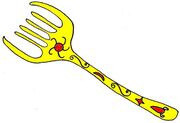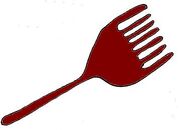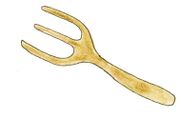Welsh Love-Fork
Although the Welsh Love-Fork is not as well known as its cousin the Love-Spoon, the Love-Fork has an equally venerable history. The earliest known example was unearthed in 1742 near the famous Dolau Cothi Gold mines in Pumpsaint Wales. It was carved from boxwood and inlaid with river pearl and slate lozenges. Contemporary accounts describe it as ‘an exquisite piece , verily more of a jewelle than a toole’. Unfortunately in the harsh winter of 1967 this legendary masterpiece was burnt to a cinder in an ill-advised toast making incident.
A Brief History of Tines[edit]
Although theoretically possible for Love-Forks to have an infinite number of prongs or 'tines' in practice it was too soul-destroying to whittle many more than twelve.
Fork Craft[edit]
Traditionally the LOVE-FORK was hewn from seasoned wood - ash and oak being the favoured materials; though in times of stress and hardship pieces of hawthorne were used and the skilled carver was able to add an extra nuance to his craft by retaining the sharp thorns on the fork handle. There are no extant examples of forks made out of metal although in the National Love-Fork Museum in Llandovery Carmarthenshire there are a few lovely specimens carved from the discarded thigh bones of Welsh Mountain Sheep.
Tools for Love?[edit]
Whilst the Welsh Love-Spoon was traditionally associated with long winter evenings, frustration and courtship, the Welsh Love-Fork was used primarily as a communication tool between husband and wife. By counting the number of prongs or tines, a husband or wife were able to semaphore their wishes and desires without the tedious necessity of speaking to one another.
The Lore of the Love-Fork[edit]
2 prongs: What about an early night ?
3 prongs: I’ve got a headache
4 prongs: Where’s my dinner?
5 prongs: Oh No. Not Leek Surprise again!
6 prongs: What did your last slave die from?
7 prongs: Did you steal these flowers from someone's grave?
8 prongs: It’s not you - it’s me.
9 prongs: It’s not me - it’s you.
10 prongs: I’ve met someone else.
11 prongs: So have I.
12 prongs: Whatever ...
13 prongs: I need a life...


